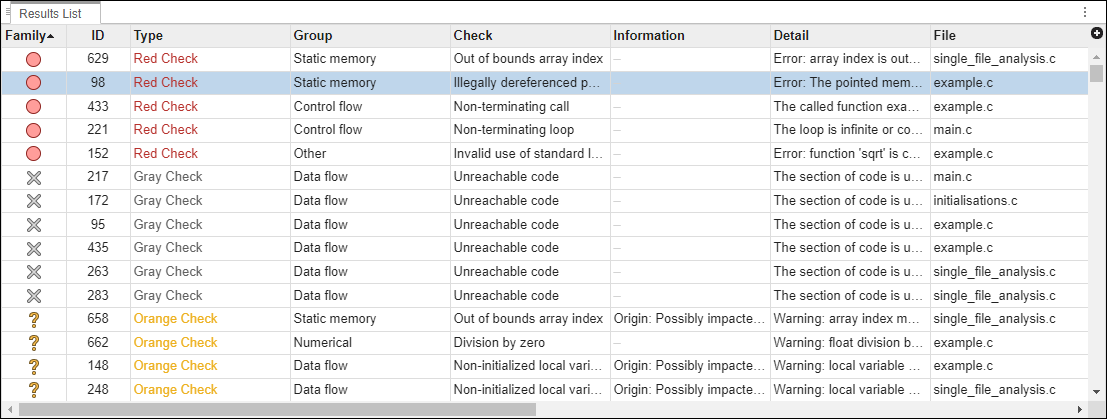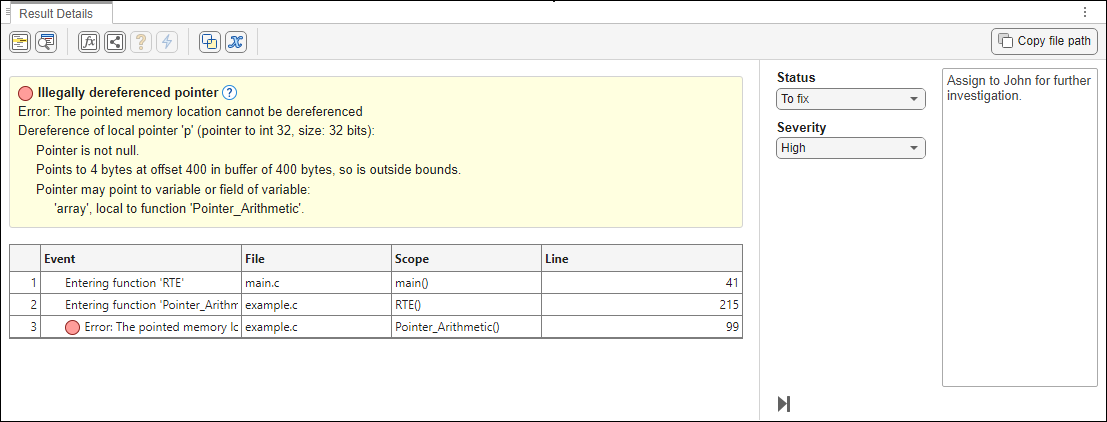Review Polyspace Code Prover Analysis Results in Polyspace Platform User Interface
Polyspace® Code Prover™ checks C/C++ code exhaustively and proves the absence of certain types of run-time errors (static analysis or verification). After running the analysis, you open the results in the Polyspace Platform user interface.
This topic uses example results to show how to review results in the Polyspace Platform user interface.
If you run an analysis using a Polyspace Server product and upload to Polyspace Access, you can review the results in a web browser. See Review Polyspace Bug Finder Results in Web Browser.
Example Files
To follow the steps in this tutorial, run Polyspace using the steps in Run Polyspace Code Prover on Desktop.
Alternatively, in the Polyspace Platform user interface, open an example project using Help > Examples > Prove absence of C runtime errors. Run an analysis by clicking Prove Absence of RTEs in the toolstrip. The Prove Absence of RTEs button shares a drop-down menu with the Find Issues button.
Interpret Results
Review each Polyspace result. Find the root cause of the issue.
Start by opening your results in the Review perspective. Double-click your result file from the Results pane to open the Project Overview dashboard. Select Review from the toolbar to open the Review perspective containing all results and details.
Start from the list of results on the Results List pane. If the Results List pane covers the entire window, select Layout > Reset.
Click the Family column header to sort the results based on how
critical they are. Select the red Illegally dereferenced pointer check
in the file example.c. A red check indicates that the error happens on
all execution paths considered in the analysis.

View code information on the Source Code pane and further information about the result on the Result Details pane.
For the Illegally dereferenced pointer result, the message on the
Result Details pane indicates that the pointer p
has an allowed buffer of 400 bytes. It points to a location that begins at 400 bytes from
the beginning of the buffer and points to a data type of 4 bytes.
To investigate further and find the root cause of the issue, right-click the variable
p on the Source pane and select Search
For All References. Click each search result to navigate to the corresponding
location on the source code. At each location, place your cursor on the variable
p to see a tooltip that describes the variable value at that point in
the code.

You see that the pointer variable p is initialized to a 100-element
int array. The pointer traverses the array in a for
loop with 100 iterations and points to the end of the array. On the line with the red
Illegally dereferenced pointer check, this pointer is dereferenced,
resulting in dereference of a memory location outside the array.
Additional Information
See:
Address Results Through Bug Fix or Comments
Once you understand the root cause of a Polyspace finding, you can fix your code. Otherwise, add comments to your Polyspace results to fix the code later or to justify the result. You can use the comments to keep track of your review progress.
If you do not want to fix the defect immediately, assign a status to the result in the Result Details pane. For example, To investigate. Optionally, add comments with further explanation.

If you assign a status No action planned, the result does not appear in subsequent runs on the same project.
Additional Information
See:
Manage Results
When you open the results of a Code Prover analysis, you see a list of run-time checks, coding rule violations or other results. To organize your review, you can narrow down the list or group results by file or result type.
For instance, you can:
Review only red and critical orange checks.
Click the Family column header to sort checks by color. Alternatively, you can filter out results other than red and orange checks. Click the Run-time Checks drop down list in the toolstrip and select Red and Orange to filter the Results List to show only red and orange results..

You can review only the path-related orange checks because they are likely to be more critical. To filter out other checks, use filters for columns such as the Information column. Select the Information column to sort the column alphabetically. Right-click the Origin: Path related issue and select Show only to view only results with the Origin: Path related issue information.
Review only the new results since the last analysis.
On the Filters section of the toolbar, click the drop down arrow and select New from the Resolution section.
Review results in certain files or functions.
On the Results List pane, right-click a result in the File column and select Show only: "filename.c" to view only the results in that file. You can use this method on any column in the Results List. Additionally, select the header of any column to sort the Results List by the information in the column.
Additional Information
See: